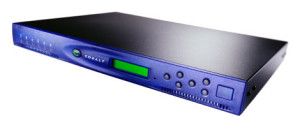Garage sale at the office: Good chance to grab on some (very) old hardware, like an APC 9221 PDU. Yes, it’s old (some 15 years or so), so surely not state of the art. But yet good enough to use in my home lab. Who could tell that there were some unforeseen issues waiting for me …
Read more…
It’s been a while since my last post and I’ve been quiet busy writing on my graduation essay.
Meanwhilst my colleague Steven donated me a somewhat dated PC Engines Alix computer. I though to put it to some good use as a packet generator for my new network playground I’m currently building up.
Funny anectode: While googl’ing around on some docs about Alix computers, I stumled accross his 2009 original post on FreeBSD installs.
But then I read that I’d need to go through config hell for DHCP, PXE, NFS for a one-time install … Oh boy, must be kidding …
Transform Cobalt Raq3 into a Raspberry Pi-powered Media Center
Anyone remember these adorable blueish 1U servers made by Cobalt Networks?
While I was never in true love with the Cobalt OS itself, I actually liked the Cobalts Raq enclosure.
So much that I salvaged one while cleaning out a data center last summer. I decided to grant it a second live as a media center box running OSMC.
And of course it’s powered by a Respberry Pi. Nowadays there’s simply no way around those nice little boxes 😉
Read more…
**** UPDATED 2018/04/27 ***
Arduino is super cool, I really love that thing, but …
Who would really want to put a fully-featured Arduino board into each and every project, at least when they’re built to more like a permanent setting?
I guess nobody. Honestly, an Arduino is not expensive to buy, but to expensive, if you want to put dozens of them in place.
So, why not put just the ATmega chip, which drives every Arduino at its heart, inside and leave all the rest away?
This is what this post The RRRRRRRRRRBBA, a $3 Arduino talks about: Just provide power to the ATmega and get rid of all the bells and whistles. You can even spare the oscillator and the resistors.
Well, this is exactly what I wanted. But since I didn’t have the proper gear at hands to flash the ATmega chip, I first had to look into another topic, namely how to turn your existing Arduino into an ASP (in-system programmer).
Here’s some of the pages I came along:
Arduino ISP
Arduino to Breadboard
The Arduino Micro schematic
Arduino Leonardo as ISP
Arduino Micro as ISP and atTiny84A
But I soon found that doing so with an Arduino Micro, the only one I had available at that time, is not as straight forward as with other Arduino boards.
So I did this writeup to cover my findings on this.
Read more…
The culprit with technology is always the same: to old, to buggy, something missing here and there.
Adding something new usually urges you to add even more to get it running, so in the end, yeah, you know, why didn’t I stay with what I had before?
So to speak recently when I hooked a Raspberry Pi equipped with Raspbmc to my almost prehistoric Philips 42PF9966/10 plasma tv.
The reasing for doing so? Well, I use XBMC on a (jailbroken) Apple TV 2 for some time now and got fond of it.
Yet, for some obscure reason, the ATV2 only works properly when connected to my ultra cheap noname TV through HDMI.
With my Philips TV, the ATV2 would just refrain from working. All I’d get is a black screen and nothing else. Apple declares this being because of the connector type, because the Philips TV offers only one DVI digital input. Well, seems they didn’t know that HDMI was designed for backwards-compatibility with DVI, it uses the same protocols, but … yeah … you know … 😉
So, when I heard about upcoming XBMC supporting the Raspberry Pi, I gave it a try.
I was happy to see that it indeed worked on my Philips TV. But since I had only one digital input, which was taken up by my Bluray player, I had to put a new A/V receiver in between to get enough inputs.
So after hooking up everything to my new Onkyo receiver through HDMI, connecting the later with HDMI-to-DVI to the Philips TV, I soon found that the Raspi wouldn’t give video output. And neither would it give an audio signal. Still, the Sony BD player worked like a charm.
So I connected the Raspi directly to the Philips again, which finally gave a video signal, but only after rebooting the box. After reconnecting it to the receiver, I finally got a video singal through the receiver, but still no audio, and yet, it wouldn’t last after the next reboot.
Reading on some Raspberry Pi internal workings, I found this:
- The Raspberry Pi does always fall back to Composite output if no HDMI display is found during startup
- If the HDMI display does not support audio capability, audio output on HDMI is disabled
Well, that seemed at least to explain it.
To get around it, I had to to force the Raspberry Pi to always drive the HDMI output, regardless if a display was connected or not.
According to http://elinux.org/RPiconfig these are the settings, that need to be added to /boot/config.txt to achieve this.
hdmi_force_hotplug=1 hdmi_drive=2 hdmi_group=1
However I still had some issues getting video output to work properly. Especially, I couldn’t get stable 720p output, so I had to force it to 1080i. These symptoms went away using these settings:
config_hdmi_boost=4 hdmi_mode=5
Still I had no audio. To get this working, I had do force audio output via HDMI. Additionally, I really had to enable the “ignore edid” data mode, although I wouldn’t expect my Philips TV being a “crappy Chinese one” as stated in the docs 😉
hdmi_ignore_edid=0xa5000080 hdmi_force_edid_audio=1
After all, everything works fine now, so no reason to buy a new TV 🙂
Out of a sudden iTunes struck me with this error: The iPhone “…” could not be synced because the sync session failed to start
I did web research, but did not really find a proper solution to this.
Well, there were a few which either did some funny things on Windows (I run a Mac ….), or recommended to restore the iPhone from a previous backup, removing just one app, installing just one new app through the iTunes store, and, well, some other curious and strange things.
After all, I thought to give the restore thing a try, however that changed nothing. Same message came up. So I disabled WLAN sync as to not interfere with the iPhone being hooked up by the cable already — again to no avail.
So I decided to look into the iTunes internals. There I found a primising folder within the Application Library folder called SyncServices. It was not that big, around 6 megs. But inside there where clear traces of synchronisation stuff.
My solution to the above error was then to quit iTunes, remove the SyncServices folders completely. And voila, iTunes would just start syncing my iPhone as if nothing bad had ever happened.
Today I got a complementary SqueezeBox Radio to join two SqueezeBox Boom and a SqueezeBox Classic at my home.
As I’m preparing to move homes very soon, I’m currently without broadband internet at home (this post is written through a 3G wireless connection).
But here’s the pitfall: How would you setup a so declared internet radio without a working internet connection?
After all Logitech’s first time wizard seems to require an internet connection, otherwise you’ll be stuck with an error message. Because I’m using all my SqueezeBoxes with the SqueezeBox Server only, I’m not dependending on the internet connection. Luckily, there’s a (undocumented) way to work around this.
Read more…
DrayTek Vigor 2600v does some DNS spoofing
I always wondered about an obscure behaviour observed in my home network.
Whenever I access my website using it’s plain domain name (http://phunsites.net), I’d end up with a password prompt from my DSL router.
What a shame: After four years of service my 3rd generation MacBook Pro broke last wednesday – obviously a well-known issue with the Nvidia GPU. Strangely enough, this really is easily to be fixed with your kitchen’s baking oven…
Currently playing around with my Netra T1 105 and a Sun StorEdge Multipack enclosure, I wondered if I really could add the whole enclosure while the host is online.
I used to do hot-plugging before, but I’ve never done this with a whole enclosure at once. Well worth a try?
Read more…


